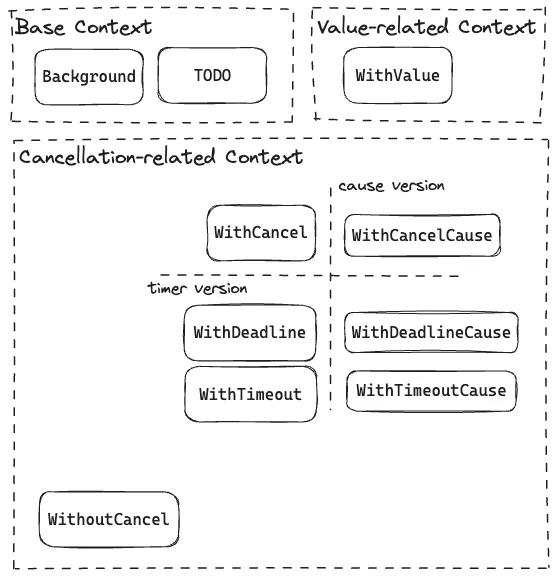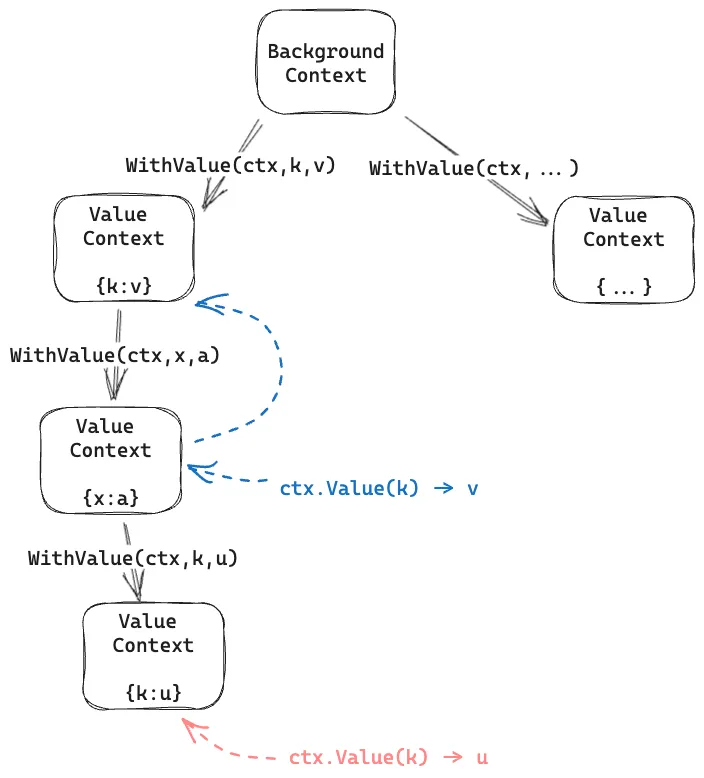context is one of the most commonly used standard library package in Golang.
This package is originally designed to provide a consistant interface of passing request-scoped values and cancellation signals across different libraries used in handling a request.
In this post, we explore the internal of context.Context and how it is implemented.
First Look
The core interface context.Context is defined as follows. Value(key any) any is used to query a scoped value by its key, while the other methods are related to cancellation signals (discussed later).
type Context interface {
Deadline() (deadline time.Time, ok bool)
Done() <-chan struct{}
Err() error
Value(key any) any
}The package provides several context creation functions. Background and TODO are used to create a base context. These two type of contexts are almost the same, except the semantics of TODO is a placeholder.
WithValue creates a new context with an additional KV pair other than the parent context.
func Background() Context
func TODO() Context
func WithValue(parent Context, key, val any) Context
func WithCancel(parent Context) (ctx Context, cancel CancelFunc)
func WithCancelCause(parent Context) (ctx Context, cancel CancelCauseFunc)
func WithoutCancel(parent Context) Context
func WithDeadline(parent Context, d time.Time) (Context, CancelFunc)
func WithDeadlineCause(parent Context, d time.Time, cause error) (Context, CancelFunc)
func WithTimeout(parent Context, timeout time.Duration) (Context, CancelFunc)
func WithTimeoutCause(parent Context, timeout time.Duration, cause error) (Context, CancelFunc)The other types of contexts are cancellation related, among which WithCancel is the core. It creates a new context with a corresponding cancel function, which can be used to cancel the context and all its descendants.
WithDeadline and WithTimeout are similar to WithCancel, but with a timer to automatically cancel the context after a certain time.
In Go 1.20, WithCancelCause, WithDeadlineCause, and WithTimeoutCause are added to provide a way to pass a cancellation cause.
WithoutCancel create a context detached from the parent’s cancellation chain.

In the following sections, we will dive into the implementation of two core functionalities: passing scoped values and cascading cancelation signals.
Passing Scoped Values
The internal structure of a value context consists of a parent context and a key-value pair.
type valueCtx struct {
Context
key, val any
}
func WithValue(parent Context, key, val any) Context {
/* ignore: sanity check */
return &valueCtx{parent, key, val}
}To query a value, it goes through the chain of Context until it finds a valueCtx with the key.
Thus if the child context has a value with the same key, it will shadow the parent’s value, while its siblings are still able to access the parent’s value.
func (c *valueCtx) Value(key any) any {
if c.key == key {
return c.val
}
return value(c.Context, key)
}
func value(c Context, key any) any {
for {
switch ctx := c.(type) {
case *valueCtx:
if key == ctx.key {
return ctx.val
}
c = ctx.Context
case *cancelCtx, withoutCancelCtx, *timerCtx:
/* ... */
c = ctx.Context
case backgroundCtx, todoCtx:
return nil
default:
return c.Value(key)
}
}
}The process of querying a value is illustrated as follows.

Cascading Cancellation Signals
The following snippet shows the common usage of cancelable context. A job creates a child context from the parent context and passes it to a task. Upon an error, the job cancels the context. In each step, the task checks whether the context is canceled, and early returns if so.
func job(ctx context.Context) {
ctx, cancel := context.WithCancel(ctx)
go task(ctx)
if /* on error */ {
cancel()
}
}
func task(ctx context.Context) error {
for i := 0; i < 3; i++ {
select {
case <-ctx.Done():
return ctx.Err()
default:
step(i)
}
}
return nil
}The Context.Done method returns a read-only channel, which will never return a value but only be closed when the context is canceled. It’s common to check the Done channel in a non-blocking manner (select with a default case). The Err method returns the cancellation error and should be only called after the Done channel returns.
In the rest of this section, we will go through the lifecycle of a context created by WithCancel.
First, let’s look at the internal structure and the creation of a cancel context. On creation, it simply creates a wrapper of the parent context and registers itself to the parent’s cancellation chain.
type cancelCtx struct {
Context
mu sync.Mutex // protects following fields
done atomic.Value // of chan struct{}, created lazily, closed by first cancel call
children map[canceler]struct{} // set to nil by the first cancel call
err error // set to non-nil by the first cancel call
cause error // set to non-nil by the first cancel call
}
func WithCancel(parent Context) (ctx Context, cancel CancelFunc) {
c := withCancel(parent)
return c, func() { c.cancel(true, Canceled, nil) }
}
func withCancel(parent Context) *cancelCtx {
if parent == nil {
panic("cannot create context from nil parent")
}
c := &cancelCtx{}
c.propagateCancel(parent, c)
return c
}propagateCancel will be discussed more detailed later. For now we just assume it registers itself to the parent’s children field, as follows.
func (c *cancelCtx) propagateCancel(parent Context, child canceler) {
c.Context = parent
p.mu.Lock()
if p.children == nil {
p.children = make(map[canceler]struct{})
}
p.children[child] = struct{}{}
p.mu.Unlock()
return
}When asked if the context is done, it returns the channel stored in the atomic field done. If the channel is not created, it creates one and stores it in the field. This lazy creation is to avoid the overhead of creating an unused channel.
func (c *cancelCtx) Done() <-chan struct{} {
d := c.done.Load()
if d != nil {
return d.(chan struct{})
}
c.mu.Lock()
defer c.mu.Unlock()
d = c.done.Load()
if d == nil {
d = make(chan struct{})
c.done.Store(d)
}
return d.(chan struct{})
}When cancel is called, it sets the err and cause fields to the given error. Then, if the done channel is created, it closes the channel. Finally, it cancels all its children cascadingly.
func (c *cancelCtx) cancel(removeFromParent bool, err, cause error) {
if err == nil {
panic("context: internal error: missing cancel error")
}
if cause == nil {
cause = err
}
c.mu.Lock()
if c.err != nil {
c.mu.Unlock()
return // already canceled
}
c.err = err
c.cause = cause
d, _ := c.done.Load().(chan struct{})
if d == nil {
c.done.Store(closedchan)
} else {
close(d)
}
for child := range c.children {
// NOTE: acquiring the child's lock while holding parent's lock.
child.cancel(false, err, cause)
}
c.children = nil
c.mu.Unlock()
if removeFromParent {
removeChild(c.Context, c)
}
}Recall that WithCancel returns a function literal c.cancel(true, Canceled, nil) as the cancel function. The first argument true indicates that the child context should be removed from the parent’s cancellation chain, avoiding the redundant cancellation from the parent. And the second argument Canceled is a predefined error value in the package.
Now we go back to the propagateCancel method. When a cancelable context is created, it calls this method to register itself to the parent’s cancellation chain (in particular, the first ancestor of type *cancelCtx). First, this method ensures that the parent context is cancelable and has not been canceled. Then, it adds itself to the parent’s children map. The creation of the children map is lazy, the same as the done channel.
func (c *cancelCtx) propagateCancel(parent Context, child canceler) {
c.Context = parent
done := parent.Done()
if done == nil {
return // parent is never canceled
}
select {
case <-done:
// parent is already canceled
child.cancel(false, parent.Err(), Cause(parent))
return
default:
}
if p, ok := parentCancelCtx(parent); ok {
// parent is a *cancelCtx, or derives from one.
p.mu.Lock()
if p.err != nil {
// parent has already been canceled
child.cancel(false, p.err, p.cause)
} else {
if p.children == nil {
p.children = make(map[canceler]struct{})
}
p.children[child] = struct{}{}
}
p.mu.Unlock()
return
}
if a, ok := parent.(afterFuncer); ok {/*...*/}
goroutines.Add(1)
go func() {
select {
case <-parent.Done():
child.cancel(false, parent.Err(), Cause(parent))
case <-child.Done():
}
}()
}We skip the case that the parent context is an afterFuncer in the post. The last case is used for user-defined context types, which creates a goroutine to monitor the parent’s cancellation signal. In my humble opinion, library authors should consider composing a cancelCtx to avoid an extra goroutine.
We have covered the core implementation of WithCancel. Now let’s briefly go through the timer version WithDeadline and WithTimeout.
func WithTimeout(parent Context, timeout time.Duration) (Context, CancelFunc) {
return WithDeadline(parent, time.Now().Add(timeout))
}
func WithDeadline(parent Context, d time.Time) (Context, CancelFunc) {
return WithDeadlineCause(parent, d, nil)
}
func WithDeadlineCause(parent Context, d time.Time, cause error) (Context, CancelFunc) {
if parent == nil {
panic("cannot create context from nil parent")
}
if cur, ok := parent.Deadline(); ok && cur.Before(d) {
// The current deadline is already sooner than the new one.
return WithCancel(parent)
}
c := &timerCtx{
deadline: d,
}
c.cancelCtx.propagateCancel(parent, c)
dur := time.Until(d)
if dur <= 0 {
c.cancel(true, DeadlineExceeded, cause) // deadline has already passed
return c, func() { c.cancel(false, Canceled, nil) }
}
c.mu.Lock()
defer c.mu.Unlock()
if c.err == nil {
c.timer = time.AfterFunc(dur, func() {
c.cancel(true, DeadlineExceeded, cause)
})
}
return c, func() { c.cancel(true, Canceled, nil) }
}
type timerCtx struct {
cancelCtx
timer *time.Timer // Under cancelCtx.mu.
deadline time.Time
}The timerCtx is a wrapper of cancelCtx with additional timer and deadline fields. The timer field employs the time.AfterFunc function to execute c.cancel(true, DeadlineExceeded, cause) after the deadline. The deadline field records the deadline time and can be queried by the Deadline method. This method is usually used to determine whether a time-consuming step should be started.
Now we have covered the core of context package itself. In the following section, we will look at some standard library packages that use context to learn how to use it properly.
Case Study: runtime/trace
runtime/trace is a package used to trace the execution of a Go program. It employs context to pass the trace context without an explicit parameter. The following snippet shows the usage from the user’s perspective.
func MyTask(ctx context.Context) {
ctx, task := trace.NewTask(ctx, "MyTask")
defer task.End()
// ... do something
}Inside the trace package, the NewTask function retrieves the current task from the parent context, creates a sub-task, and returns the new context with the sub-task.
type traceContextKey struct{}
func NewTask(pctx context.Context, taskType string) (ctx context.Context, task *Task) {
pid := fromContext(pctx).id
id := newID()
userTaskCreate(id, pid, taskType)
s := &Task{id: id}
return context.WithValue(pctx, traceContextKey{}, s), s
}
func fromContext(ctx context.Context) *Task {
if s, ok := ctx.Value(traceContextKey{}).(*Task); ok {
return s
}
return &bgTask
}Lesson learned
- Use package level context key (private type
traceContextKeyin this case) to avoid key conflicts - Provide a function to retrieve the value from the context
Conclusion
In this post, we explore the context package in Go standard library. First we introduce the common usage of context.Context, then follow two threads of core functionality, passing scoped values and cascading cancellation signals, to dive into its implementation. In the cascading cancellation signals, we go through the lifecycle of a cancelable context and briefly look at its variants. Finally, we look at a case study of the runtime/trace package to learn some best practices.
Further Reading
- The Go blog Go Concurrency Patterns: Context describes the motivation of
contextand its usage in Google. - My previous post All’s Well That Ends Well introduces using
contextto implement a common pattern that a group of tasks should be canceled when any of them fails. - Issue #57928 context: add AfterFunc discusses the motivation of
AfterFunc, in short, to terminate a blocking call (e.g. network IO) efficiently. - Issue #40221 context: add WithoutCancel discusses the motivation of
WithoutCancel. In short, some contexts, rollback/cleanup or long-running operations for instance, should not be canceled when the parent is canceled.